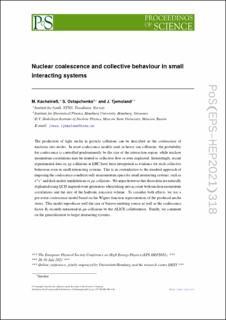| dc.contributor.author | Kachelriess, Michael | |
| dc.contributor.author | Ostapchenko, Sergey | |
| dc.contributor.author | Tjemsland, Jonas | |
| dc.date.accessioned | 2023-02-06T14:32:48Z | |
| dc.date.available | 2023-02-06T14:32:48Z | |
| dc.date.created | 2022-01-17T12:13:43Z | |
| dc.date.issued | 2022 | |
| dc.identifier.issn | 1824-8039 | |
| dc.identifier.uri | https://hdl.handle.net/11250/3048659 | |
| dc.description.abstract | The production of light nuclei in particle collisions can be described as the coalescence of nucleons into nuclei. In most coalescence models used in heavy ion collisions, the probability for coalescence is controlled predominantly by the size of the interaction region, while nucleon momentum correlations may be treated as collective flow or even neglected. Interestingly, recent experimental data on pp collisions at LHC have been interpreted as evidence for such collective behaviour even in small interacting systems. This is in contradiction to the standard approach of imposing the coalescence condition only in momentum space for small interacting systems, such as e+e− and dark matter annihilations or pp collisions. We argue however that these data are naturally explained using QCD inspired event generators when taking into account both nucleon momentum correlations and the size of the hadronic emission volume. To consider both effects, we use a per-event coalescence model based on the Wigner function representation of the produced nuclei states. This model reproduces well the size of baryon-emitting source as well as the coalescence factor B2 recently measured in pp collisions by the ALICE collaboration. Finally, we comment on the generalization to larger interacting systems | en_US |
| dc.language.iso | eng | en_US |
| dc.publisher | Sissa Medialab srl | en_US |
| dc.rights | Attribution-NonCommercial-NoDerivatives 4.0 Internasjonal | * |
| dc.rights.uri | http://creativecommons.org/licenses/by-nc-nd/4.0/deed.no | * |
| dc.title | Nuclear coalescence and collective behaviour in small interacting systems | en_US |
| dc.title.alternative | Nuclear coalescence and collective behaviour in small interacting systems | en_US |
| dc.type | Peer reviewed | en_US |
| dc.type | Journal article | en_US |
| dc.description.version | publishedVersion | en_US |
| dc.source.journal | Proceedings of Science (PoS) | en_US |
| dc.identifier.doi | https://doi.org/10.22323/1.398.0318 | |
| dc.identifier.cristin | 1982454 | |
| cristin.ispublished | true | |
| cristin.fulltext | original | |
| cristin.qualitycode | 1 | |

